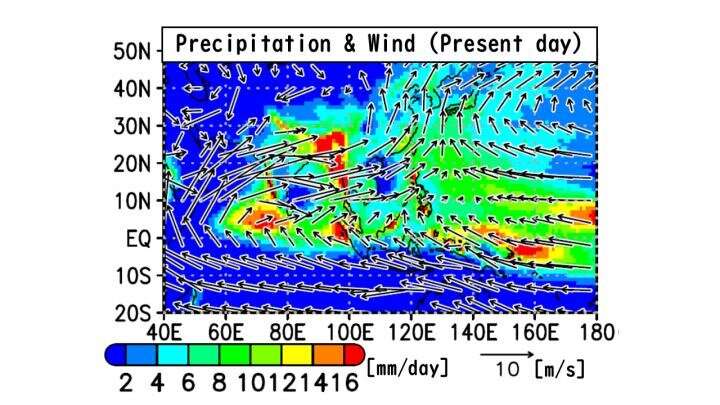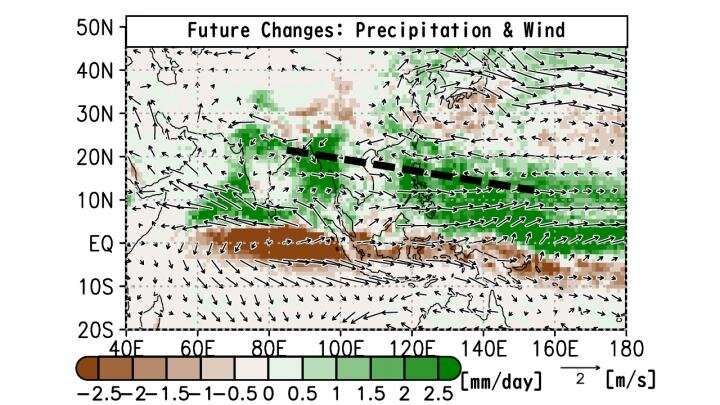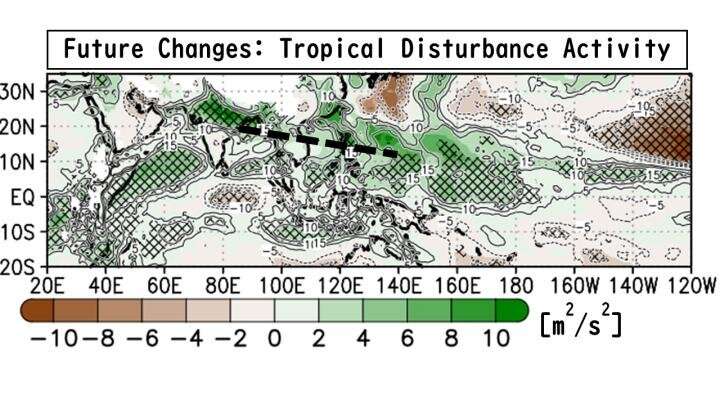Wetter than wet: Global warming means more rain for Asian monsoon regions

Researchers from Tokyo Metropolitan University studied how the weather will change with global warming in Asian monsoon regions using a high-resolution climate simulation. The region is home to a large population, and the monsoons are a major driver of global water cycles. They explicitly simulated cloud formation and dissipation, and found significantly increased precipitation over the monsoon "trough," with tropical disturbances such as typhoons and concentrated water vapor playing key roles.
As the world braces itself for the impact of global warming, it is now more vital than ever to have an accurate, detailed picture of how exactly the climate will change. This applies strongly to the Asian monsoon regions, where vast amounts of annual precipitation make it an important part of global energy and water cycles. As home to a large proportion of the world population, detailed, local predictions for the scale and nature of monsoons and tropical disturbances such as typhoons/cyclones have the potential to inform disaster mitigation strategies and key policymaking.
A team led by Assistant Professor Hiroshi Takahashi sought to address this by using a high-resolution climate model known as NICAM (Non-hydrostatic ICosahedral Atmospheric Model) to study the detailed evolution of weather in the Asian monsoon regions. The model's key strength is an explicit account of cloud formation and dissipation based on physical principles e.g. accounting for the convective effects that give rise to cumulonimbus clouds and subsequent precipitation when the air pressure drops. This level of detail allowed the team to study future precipitation patterns due to Asian monsoons with unprecedented accuracy.
-

Changes in rainfall (future climate minus present climate) (green: increase, brown: decrease). Black dotted line shows the center of the monsoon trough. Tropical disturbances move along the monsoon trough. Vectors show wind in the lower troposphere. A circulation is created anticlockwise (low pressure) around the monsoon trough, and correlates well with increased rain. Credit: Tokyo Metropolitan University -

Future changes in tropical disturbance activity (e.g. typhoons/cyclones) (perturbation kinetic energy [m2s-2]) (green: more activity, brown: less, gridded areas: statistically significant changes). Black dotted line shows the center of the monsoon trough. Increased tropical disturbance activity correlates well with increased precipitation along the monsoon trough. Credit: Tokyo Metropolitan University
The team's simulation of 30 years of global warming shows significantly elevated levels of precipitation in the monsoon "trough," a zone spanning northern India, the Indochina peninsula, and the western parts of the North Pacific. It is well known that global warming leads to more precipitation, driven mostly by more water vapor in the atmosphere. However, the different features of each region mean that the changes are far from uniform. For example, the study found that it was not clear whether "monsoon westerlies" were enhanced, but it did find more cyclones in the trough, enough to account for the increased precipitation. Concurrent with the increased precipitation, they also found distinct trends in water vapor over the monsoon region.
Furthermore, the team focused on the effect of sea surface temperature. Previous studies often applied a global, uniform increase in temperature plus the regional variations created by the El Nino effect. To separate their effects, they added them separately in two independent simulations, concluding that it was the former, a global increase in sea surface temperature, that contributed most strongly to the increased precipitation.
The effects of the monsoon season in Asia can be devastating. Examples include locations close to home for the team e.g. the 2018 and 2020 floods in western Japan and the East Asian countries. With these region-specific findings, their work may play an important role in global disaster mitigation, infrastructure development and policy decisions.
More information: Takahashi et al., Response of the Asian Summer Monsoon Precipitation to Global Warming in a High-Resolution Global Nonhydrostatic Model. J. Climate (2020). DOI: DOI: 10.1175/JCLI-D-19-0824.1
Provided by Tokyo Metropolitan University




















